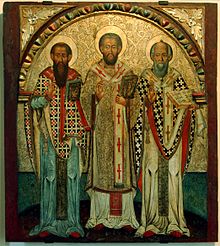Consensus quinquesaecularis
Consensus quinquesaecularis ( Latin ; " Consensus of the [first] five centuries") is a term from the history of Christian theology that is rarely used today. It has its place in interdenominational dialogue and formulates the view that in the first five centuries of church history , the time of the "undivided" old church , there was an agreement in the basic doctrines of the Christian faith, which is sufficient as the basis for a church unity that is to be striven for today . Doctrines and doctrinal differences added later are less significant and do not have to be church-dividing.
Concept history
Georg Calixt
The Lutheran Irish Georg Calixt (1586–1656) is considered to be the originator of the term . He developed it - under the name Consensus antiquitatis - in 1626 in the introduction to his edition of Augustine ' De doctrina christiana and Vincent' by Lerin Commonitorium (with its famous definition of " Catholic ", from all Christians to believers). The expression Consensus quinquesaecularis , which was later generally received, coined - rejecting - Johann Georg Dorsche in 1648. Calixt used the concept again and again in the following decades to emphasize the cross-denominational agreement in the Apostles' Creed , in the doctrine of the Trinity , Christology and Soteriology and to emphasize "younger" Roman Catholic doctrines and customs - the Eucharistic transubstantiation , the number of the sacraments , purgatory , indulgences and masses , priestly celibacy and the invocation of the saints - as subordinate and negotiable. In doing so, he explicitly excluded the traditional principle and the papal primacy .
Early review
Although it was primarily addressed to Catholic theologians and prepared by old-faith humanists of the Reformation period such as Georg Witzel and Georg Cassander , Calixt's concept found little echo there. Above all, the Jesuit Vitus Erbermann asserted the tradition, which has gone on in the Church at all times through the Holy Spirit, and the teaching authority of the papal office against a consensus antiquitatis without compromise.
The negative response was much stronger on the part of Lutheran orthodoxy , where the consensus concept as a relativization of the scriptural principle and the Reformation doctrine of justification was sometimes violently rejected and discredited as syncretism .
Positive effect
The concept was positively received by Anglican theologians of the 18th and 19th centuries in the course of the development of Anglo-Catholicism . According to the Roman Catholic dogma definitions of 1854 and 1870 , it was Ignaz von Döllinger in particular who resorted to the concept as a basis for dialogue with both Orthodox and Protestants , for example at the Bonn Union conferences he initiated . The old Catholic Church emerging at that time invokes the Consensus quinquesaecularis with its name. The ecumenical movement of the 20th and 21st centuries hardly uses the term anymore, but it is factual in its history of impact.
Today's criticism
Today, the notion of a five-hundred-year Christian consensus is viewed by many historians of dogma as fictional, since it can only be sustained by ignoring all early and early Christian controversies and divisions. In addition, the underlying historical-philosophical model of decadence is called into question, according to which the older is also the better and truer - a figure of thought that Calixt adopted from the Renaissance humanism of his time.
literature
- Andreas Merkt : The patristic principle. A study on the theological significance of the church fathers . Leiden-Boston-Cologne 2001 ( partially digitized )

